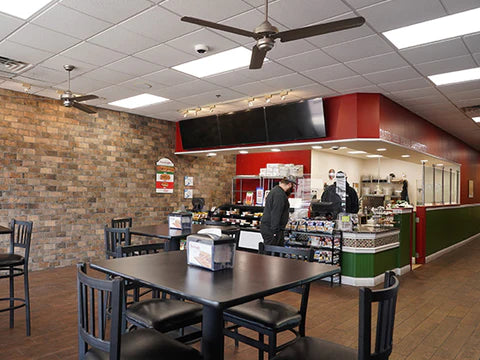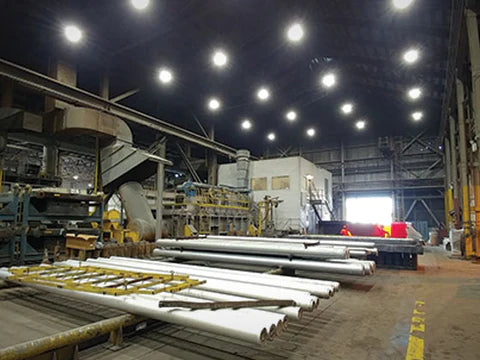What is the Difference Between Color Temperature and Color Rendering Index in LED Lighting, and Why Do They Matter?
Correlated color temperature (CCT) and color rendering index (CRI) are two key factors to consider when selecting your LED lighting. Both aspects play a significant role in creating the desired ambience and ensuring accurate color representation. This article will explain the differences between color temperature and CRI and how to choose the best combination for your application.
Correlated Color Temperature: Defining the Hue of Light
Color temperature, measured in Kelvins (K), refers to the appearance of light emitted by a light source. It indicates whether the light will appear warm (yellowish), neutral, or cool (bluish) in hue. Color temperature influences the overall atmosphere and mood of a space. It can also affect visual comfort, task performance, and circadian rhythms. Understanding color temperature is helpful when it comes to choosing the right lighting for your space.
Here's a general guide to color temperature ranges:
- Warm White (2,700K - 3,000K): Creates a cozy and intimate ambiance, ideal for residential spaces, restaurants, and hotel lobbies. Lights in this warmer range can reduce stress and promote relaxation.
- Neutral White (3,500K - 4,500K): Offers a balanced and neutral tone, suitable for offices, retail stores, and showrooms. Its neutral quality renders colors more accurately by avoiding warm or cool casts. It is also good for healthcare and educational facilities, providing adequate illumination for tasks and supporting concentration and focus without being overstimulating.
- Cool White (5,000K - 6,500K): Produces a crisp and invigorating light, perfect for task-oriented spaces, workshops, or sports facilities. These cooler color temperatures can boost alertness and cognitive function. However, light in this range can also suppress melatonin production. Melatonin promotes relaxation and sleep, so this bluer end of the spectrum wouldn't be ideal for evening or nighttime lighting, including street lighting. For those, you'll want to stick with neutral and warm CCT ranges.
Color Rendering Index: Assessing Color Accuracy
Color rendering index (CRI) is a numerical scale (0 to 100) that represents a light source's ability to accurately reproduce colors compared to natural sunlight. A higher CRI value indicates better color rendering, ensuring that colors appear true-to-life under the light source. This is particularly important in applications where color accuracy is crucial, such as art galleries, retail displays, and photography studios.
CRI and Indoor Lighting
For most general indoor applications, a CRI of 80 or higher is considered suitable. However, for more color-critical tasks, a CRI of 90 or above is recommended to ensure the most accurate color representation.
CRI and Outdoor Lighting
While 70 CRI is generally sufficient for most outdoor lighting applications, there are certain situations where higher CRI values greater than 80 or 90 can be beneficial, such as:
- Sports facilities where a higher CRI can improve visibility
- Outdoor event venues and outdoor dining areas where a high CRI can improve the visual experience
- Exteriors of businesses that rely on visual appeal to attract customers, including restaurants, hotels, and high-end car dealerships.
Additional Considerations
When comparing CRI across lighting options, keep in mind that CRI and efficiency operate in relation to one another: The higher the CRI, the lower the light's efficiency.
This is because a high CRI requires a wider, fuller spectrum to achieve its approximation of natural daylight, while high luminous efficacy, or what you may think of as "perceived brightness", is best achieved at a narrower spectrum, in the 545-555 nm wavelength range. Outside of that narrow range, it takes more power to achieve a given level of brightness. Hence, a wider, fuller color spectrum requires more power and is less efficient to operate.
You'll need to decide on the best balance between color accuracy and energy bill reduction for your application.
The More You Know
Both color temperature and CRI play essential roles in determining the quality and effectiveness of LED lighting. Understanding the differences between them helps you select a suitable lighting solution for every space. However, it never hurts to get help. Whether you're still not sure what color temperature or CRI you should be aiming for, or you'd rather save yourself the time and trouble of poring over lighting catalogs, our lighting pros are here to help. Call, text, or email us, or submit a free lighting service request (be sure to check "Product Recommendations" and tell us about the space you need to light). Our team can save you a lot of legwork, at no additional cost to you. Ready to get started? Get in touch today:
Call 215.355.7200, Text 267.266.8330, or Email lights@eledlights.com

 215.355.7200
215.355.7200




